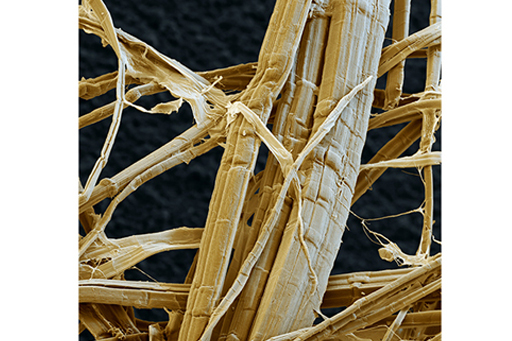4 Carbohydrates
Carbohydrate is a general term that includes various kinds of sugar, together with starch and cellulose. The carbohydrates that we eat almost all come from plants.
Honey is a rare example of a carbohydrate that seems to come from an animal –bees. However, the sugars in honey are made by plants, in the nectar in their flowers. All the bees do is collect and process the sugars to produce honey, so it is a plant carbohydrate.
Cellulose is said to be the most abundant molecule made by living organisms on Earth. About one million million (1012 ) tonnes are produced each year. It is so common because it forms the framework of the walls of all plant cells. It is composed of at least 500 glucose molecules all linked together in a long, unbranched chain. (Remember that glucose is a type of sugar.) The chains pack very closely side-by-side, similar to how some fat molecules pack, to give a very tough fibre (Figure 10). Because of the way in which the glucose molecules are linked, we cannot digest cellulose and it is known as the ‘fibre’ in our diet.
Probably the next most common carbohydrate in most people’s diet is starch. We can digest starch and, being much less energy-dense than fat, we can safely eat much greater amounts. The medical advice is that you should not have more than 50% of your total energy intake from carbohydrates. The reference intake is 260 g per day – about the same weight as a packet of butter.
When plants have spare sugars, made during photosynthesis, many of them store it as starch. In some species, we eat it before they can use it themselves! Let’s start with potatoes. These are tubers produced by the potato plant, to survive the winter and be ready to generate new plants the following spring – as long as we don’t dig them up and eat them!
Wheat and other cereal crops produce grains – their seeds for next year – containing starch. We grind them into flour – which is used to make bread and pasta – or we treat them in various ways to make breakfast cereals. Rice is a similar grain which we normally eat whole. You can probably think of other starchy foods that are similar stores put aside by plants for their own benefit, but are very nutritious for us, too.

